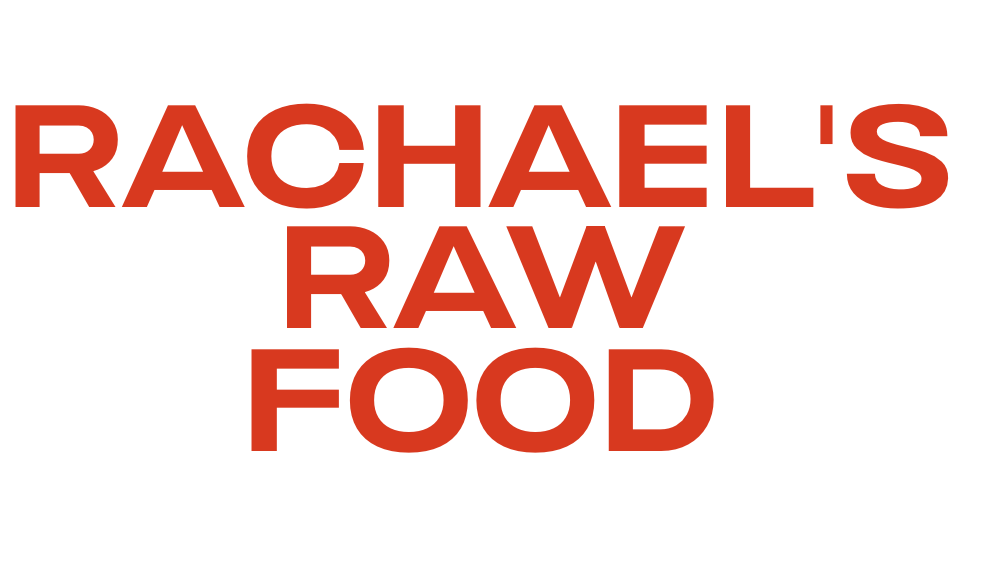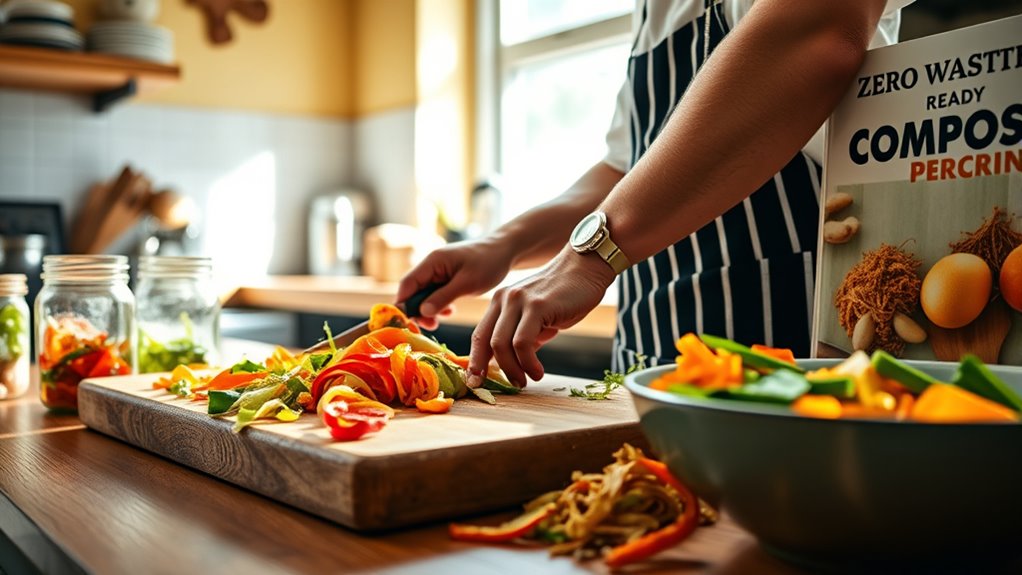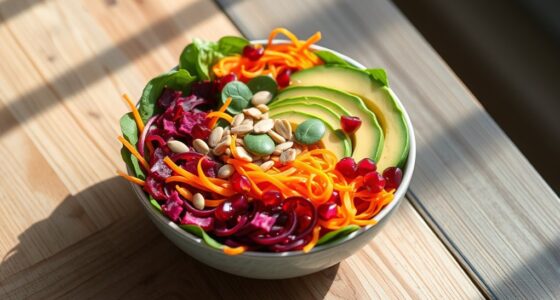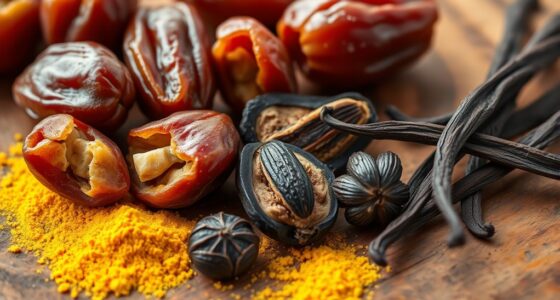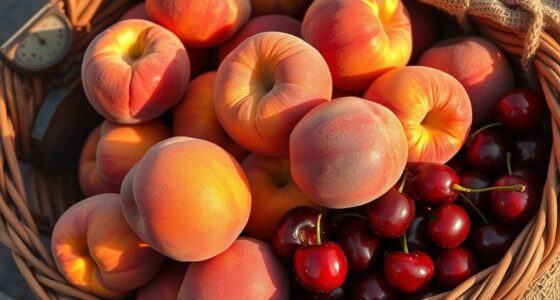In zero-waste raw cooking, you can fully use every part of produce, like peels, stems, and seeds, to reduce waste and boost flavor and nutrition. For instance, zest citrus peels, blend cucumber seeds into smoothies, or add kale stems to salads. Preserving and dehydrating leftovers extends their life and minimizes packaging waste. This approach makes your meals more sustainable and flavorful. Keep exploring to discover more creative ways to utilize every part of your produce.
Key Takeaways
- Utilize citrus peels for zest in salads, smoothies, or homemade flavorings to maximize their culinary value.
- Incorporate stems from herbs like cilantro or kale into dips, pestos, or garnishes to reduce waste.
- Dry or roast seeds from cucumbers, tomatoes, or melons to create nutritious snacks or flavor enhancers.
- Ferment peels or stems to develop probiotic-rich condiments and extend ingredient shelf life.
- Practice sustainable sourcing by choosing organic, local produce to support resourcefulness and reduce packaging waste.

Zero-waste raw cooking is a sustainable approach that emphasizes preparing fresh, uncooked foods while minimizing waste. This method encourages you to use every part of your produce—from peels and stems to seeds—reducing what ends up in the trash and making the most of your ingredients. By focusing on food preservation, you can extend the life of your fresh items and avoid unnecessary spoilage. Instead of discarding peels or stems, you find creative ways to incorporate them into your meals, ensuring nothing goes to waste. This not only supports sustainability but also adds flavor, texture, and nutrients to your dishes.
When you prioritize sustainable sourcing, you’re choosing ingredients that are ethically grown and harvested, which aligns perfectly with the zero-waste mindset. Locally sourced, organic produce often comes with less packaging and a smaller carbon footprint. You can buy from farmers’ markets or join community-supported agriculture (CSA) programs, which help you access fresh, seasonal ingredients directly from growers who prioritize sustainable practices. This connection to where your food comes from makes it easier to utilize the entire plant and reduce waste.
Using every part of your produce also means exploring creative ways to incorporate peels, stems, and seeds into your raw recipes. For example, citrus peels can be zested into salads or blended into smoothies, adding bright flavor and nutrients. Stems from herbs like cilantro or kale can be chopped finely and mixed into dips or garnishes. Seeds, such as those from cucumbers or tomatoes, are often rich in healthy fats and can be dehydrated and roasted for snacking or ground into flavorings. These practices not only cut down on waste but also enhance the nutritional value of your meals.
Food preservation techniques, like fermenting or dehydrating, play a significant role in this approach. Fermented peels or stems can become probiotic-rich snacks or toppings, while dehydrated seeds or peels can be stored for later use. This ensures you make the most of your ingredients over time, reducing the need to buy new supplies frequently. It also helps you maintain a more sustainable kitchen by decreasing the frequency of shopping trips and packaging waste.
In essence, zero-waste raw cooking is about respecting your food and the environment. By embracing food preservation and sustainable sourcing, you not only reduce waste but also enjoy fresher, more flavorful meals. It’s a simple shift in mindset that turns everyday cooking into a conscious act of sustainability, helping you minimize your ecological footprint while nourishing your body with unprocessed, wholesome foods.
Frequently Asked Questions
How Do I Store Peels and Scraps Safely for Later Use?
To store peels and scraps safely for later use, focus on food preservation by choosing airtight storage containers. Rinse the scraps if necessary, then dry them thoroughly before sealing to prevent mold. Label your containers with dates and contents, and keep them in the fridge or freezer depending on how soon you’ll use them. Proper storage minimizes waste and guarantees your peels and scraps stay fresh for future cooking.
Are There Any Ingredients That Shouldn’t Be Used Whole in Raw Cooking?
You shouldn’t use certain ingredients whole in raw cooking because fruit toxicity and seed bitterness can pose risks. For example, apple seeds contain trace amounts of cyanide, and some fruit pits release toxins or bitterness that affect flavor and safety. Always research your ingredients before using them whole, especially seeds and pits, to avoid health issues. When in doubt, remove or process these parts to enjoy raw dishes safely.
Can Stems and Seeds Be Used in Smoothies Without Preparation?
Yes, you can use stems and seeds in smoothies without much preparation. Stems, like celery or kale, add fiber utilization and a crunchy texture, while seeds, such as sunflower or pumpkin, boost nutrient intake and seed incorporation. Just make certain seeds are clean and, if necessary, lightly crushed to improve blending. This way, you maximize every part of your ingredients, reducing waste and enhancing your smoothie’s nutritional profile.
How Do I Ensure Food Safety When Using Scraps in Raw Recipes?
You guarantee food safety when using scraps in raw recipes by thoroughly washing all peels, stems, and seeds to prevent food contamination. Always use clean utensils and cutting boards to avoid cross contamination, especially when handling raw scraps. Store leftovers promptly at proper temperatures, and avoid mixing raw scraps with cooked foods. These steps help prevent food contamination and maintain safe practices in your zero-waste raw cooking.
What Are Creative Ways to Incorporate Peels Into Raw Dishes?
You can get creative by making peel infusions for dressings or drinks, adding zest and flavor. Use peels as seed garnishes to add crunch and visual appeal to salads or raw bowls. Incorporate citrus peels into chutneys or dips for a burst of freshness. Thinly sliced fruit peels also work well as edible decorations, enhancing presentation while reducing waste. Experimenting with these ideas keeps your raw dishes vibrant and eco-friendly.
Conclusion
By embracing zero-waste raw cooking and using every peel, stem, and seed, you not only reduce waste but also unveil new flavors and nutrients. Remember, “waste not, want not”—small efforts make a big difference. So, next time you’re in the kitchen, get creative and honor your ingredients. Every little bit counts toward a more sustainable and delicious lifestyle. It’s a simple change that can truly transform how you cook and live.
